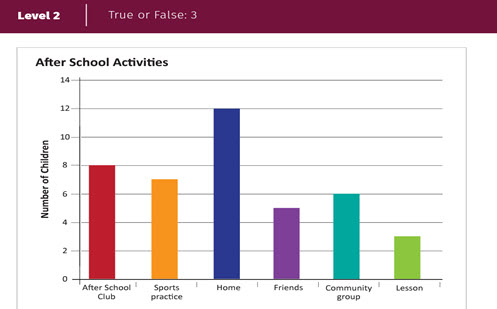Planning tool
Year levels
Strands
Expected level of development
Australian Curriculum Mathematics V9: AC9M3ST01, AC9M3ST02
Numeracy Progression: Interpreting and representing data: P4
At this level, students create and compare different graphical representations. They interpret the data and make generalisations.
Provide students with the opportunity to view data in a range of graphical representations such as tables, infographics, picture graphs, dot plots, bar or column graphs and line graphs. Use questioning to elicit responses about the differences and similarities of each data display. Discuss the intended audience and use, and how this might impact the choice of data display. Select relevant data displays found in different media and ask students to interpret and consider why that particular display might have been chosen.
Make connections to scientific investigations where data is collected from an experiment. Provide opportunities for students to use digital tools to efficiently record data in tables and use that data to create charts and graphs. Model how to use a simple two-column table to record data in a spreadsheet and create a graph.
Teaching and learning summary:
- Provide students with the opportunity to view and describe a range of graphical representations.
- Model the use of digital tools to record and represent data.
- Provide relevant contexts to create graphical representations of a dataset.

Students:
- suggest questions for statistical investigation
- interpret datasets represented in various formats
- choose an appropriate way to represent a dataset and justify their reasoning.
Some students may:
- have limited experience with a range of graphs and only be familiar with pictographs or bar/column graphs. Often the type of graph to be produced is indicated by the teacher or given in the activity. Students may not have been encouraged to consider the appropriateness of different graphical presentations. The challenge is to move the focus from producing a specified type of graphical display to choosing an appropriate graphical display for a given dataset. This can be done through discussing the advantages and disadvantages of different displays, and how certain displays are better suited to certain data types.
The Learning from home activities are designed to be used flexibly by teachers, parents and carers, as well as the students themselves. They can be used in a number of ways including to consolidate and extend learning done at school or for home schooling.
Learning intention
- We are learning to use tally marks to record data and then create a data display.
Why are we learning about this?
- Tally marks help us record observations which we use to create a visual display.
What to do
1. Look at the data in the table showing Talia’s shots at scoring a goal. In each round she took 20 shots at goal.

2. Count up the total and record the frequency of shots for each round.
3. Now you have the data with totals, think of the best way to represent the data.
4. Choose a chart or graph that shows any patterns or trends.
5. What patterns do you notice? Describe your findings.
Success criteria
I can:
- interpret data in a table
- represent data into a useful form of graphical display.
Please note: This site contains links to websites not controlled by the Australian Government or ESA. More information here.
Teaching strategies
A collection of evidence-based teaching strategies applicable to this topic. Note we have not included an exhaustive list and acknowledge that some strategies such as differentiation apply to all topics. The selected teaching strategies are suggested as particularly relevant, however you may decide to include other strategies as well.
-

Explicit teaching
Explicit teaching is about making the learning intentions and success criteria clear, with the teacher using examples and working though problems, setting relevant learning tasks and checking student understanding and providing feedback.
Go to resource -

Questioning
A culture of questioning should be encouraged and students should be comfortable to ask for clarification when they do not understand.
Go to resource -

Feedback
It has been shown that good feedback can make a significant difference to a student’s future performance.
Go to resource -

Mathematics investigation
By giving students meaningful problems to solve they are engaged and can apply their learning, thereby deepening their understanding.
Go to resource -

Multiple exposures
Providing students with multiple opportunities within different contexts to practise skills and apply concepts allows them to consolidate and deepen their understanding.
Go to resource
Teaching resources
A range of resources to support you to build your student's understanding of these concepts, their skills and procedures. The resources incorporate a variety of teaching strategies.
-

True or false
In this lesson, students make statements about data displays. They evaluate statements as true or false using the features of the data to support their evaluation.
Go to resource -

Breaking down
Use this lesson to organise time-related data so that relationships can be easily observed and interpreted.
Go to resource -

Deep Sea Diving
Use this lesson to represent and interpret the relationship between a sea creature and its favoured underwater living depth.
Go to resource -

Discussing Data
Use this lesson to analyse different ways to display data and discuss which graph shows the data most clearly.
Go to resource
